April 2018
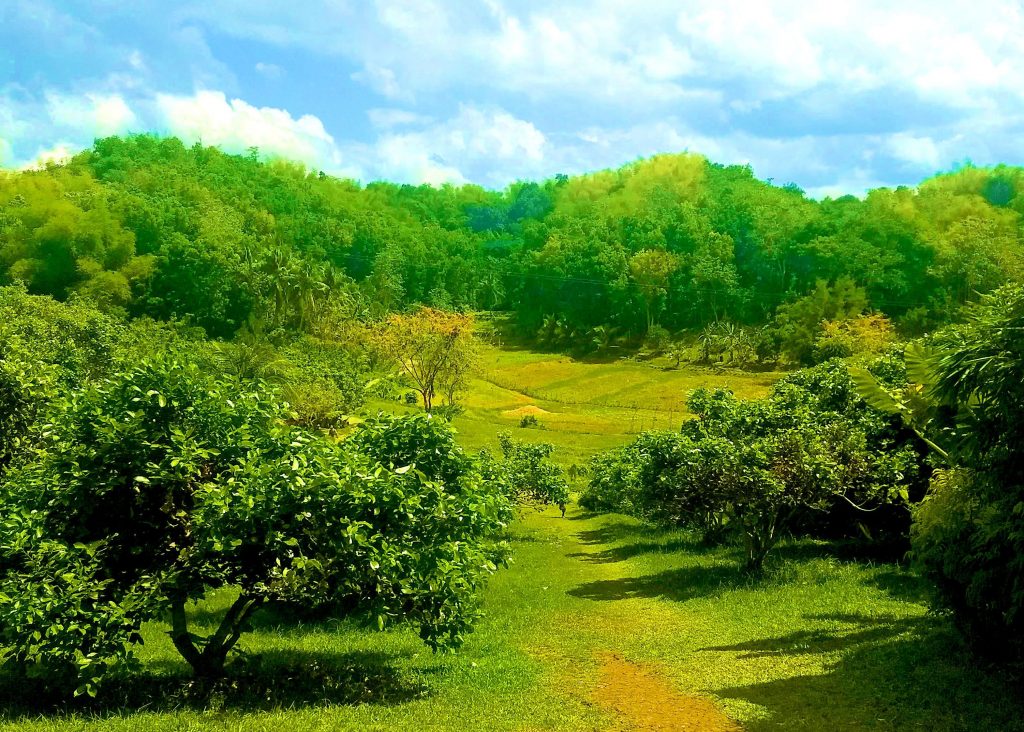
Landscape, Damires Hills, Janijuay
You may think I’m having another of my senior moments when you read the title for this piece, but I swear, if you go there you’ll know exactly what I’m talking about. Don’t ask me how someplace in the boondocks of Panay Island in the Philippines calls up such strong associations with the Cotswolds, I have no answers for you. I’m just reporting the facts, Bridget, so don’t get all up in my grill, OK? We’re talking about Damires Hills Tierra Verde Farm Resort in Janijuay, about 35 kilometers (21 miles) north of Iloilo. The last time I was there (just recently) the Rain Gods smiled favorably upon me and the weather was good. The other two times I’ve been there it was fit only for ducks, with the rain pissing down in torrents. Nipa roofs do a great job of deflecting rainwater, but a girl needs a bit of sun once in a while or she starts feeling glum, and nobody likes it when their makeup runs from the humidity. This last visit I hit the jackpot, sun galore and puffy clouds into the bargain. What more could you ask for?
Before we get started with the fun stuff, a word of advice about the approach to the resort. The access road is the work of Satan. If you’re in your own car or on your own motorbike, all well and good, proceed with caution and expect things to be … ummm … “under improvement.” If you’re taking a tricycle there from town, don’t even THINK of having it take you all the way up to Reception. Have it stop down at the bottom where the concrete tracks start and walk. Trust me, Bridget, you don’t wanna go there, especially if there’s more than one person in the tricycle. You’ll get nowhere fast and slip and slide while the tricycle driver attempts to keep the thing from tipping over. God gave you legs, so use ’em. And yes, babes, that’s the voice of experience talking. I have my own motorbike now so it’s all good, but a word to the wise is sufficient. Right??

Damires Hills, Janijuay
So, on to the fun stuff. Where to start … Let’s pretend you’re a regular tourist from, say, Oskaloosa, Iowa. You’ve got the support hose sticking out through your sandals, the wide-brimmed straw hat, the oversize sunglasses and a baggy T-shirt that says something like, “Beach Hair, Don’t Care.” We can deal with you in a jiffy. You’re gonna plop yourself down in one of the picnic pavilions — charming tika-hut things with nipa roofs, but bring a cushion or you’ll start griping long before lunch arrives because your backside is not used to sitting on bare wood, is it now, Thelma dear — and you’ll wander around a bit and take a few pics and if you feel energetic maybe stick your feet in one of the swimming pools, and then back you go to your hotel in the city. If you try to do anything else, you’ll break out in a sweat that leaves huge blotches on your T-shirt, which is (unwisely) of a color that shows the sweat so much it’ll soon look like you’ve been in a drive-by shooting. Knock ’em dead in Facebook, gals, they’re gonna eat their Franco-American hearts out.
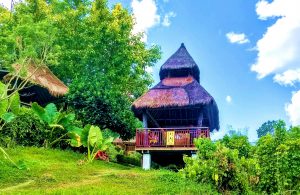
Picnic Pavilion, Damires Hills
What I propose here is something entirely different. We’re going to leave aside all the tourist stuff and look at the place as a place, not as somewhere you go to do stuff. Yes, there is a zipline. Yes, you can charge around on ATVs if that’s your heart’s desire. There are two swimming pools, very nice ones in fact, so you can splash and whoop (along with the Filipino guests) all day long if you so choose. And there’s even a bar, so you can drink yourself into oblivion while the sun shines and the rice grows. But those things really don’t require any description from Yours Truly, you can get that from the tourist brochure. What you can’t get from the tourist brochure is a sense of the place itself, and it’s an extraordinary place in a way I still don’t completely understand, so I’m going to try to puzzle it out in the hope that by the end of it all we’ll both have learned something useful. Here goes …
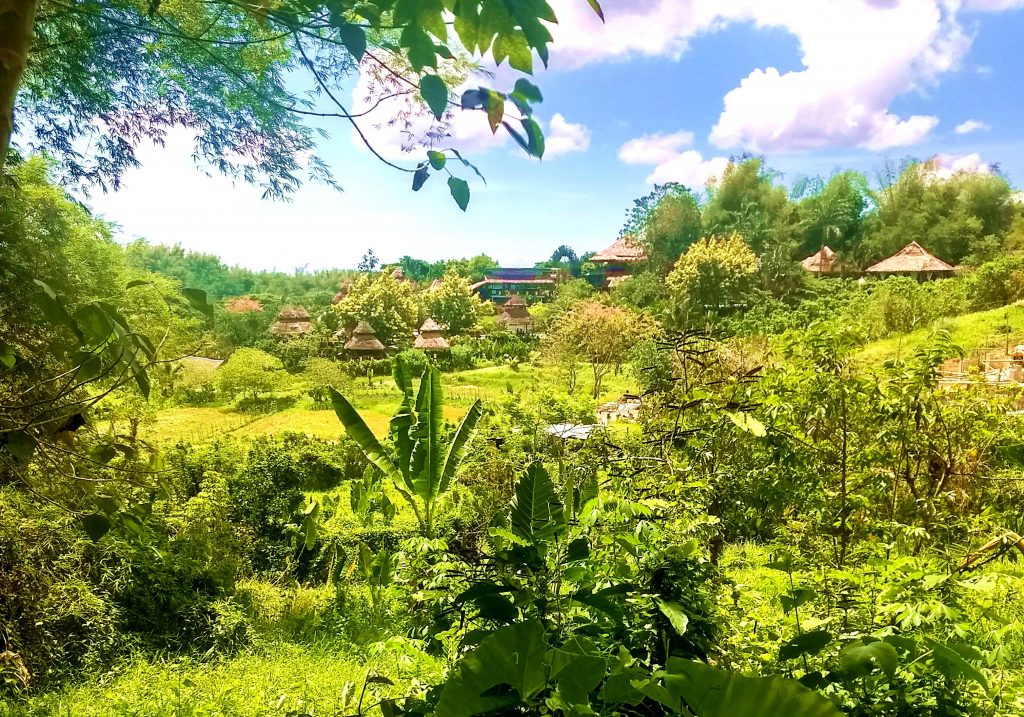
Damires Hills View, Janijuay
The first thing to note is the sense of enclave the place has. When you come through Janijuay town itself, nothing you see prepares you for what you find at the resort. Even driving through the countryside to the resort entrance, which is about 1km outside town, you will not be prepped for what you see when you pass Reception and start wandering around the resort proper. Once you do enter, I guarantee you what you saw in Janijuay town will seem a million miles away. Look at the landscape photo at the top of the post. Are you gonna find that anywhere in or around Janijuay itself? Not bloody likely, to quote George Bernard Shaw. First similarity with the Cotswolds then: things look natural but are as they are through the hand of man. We’re not talking anything on the scale of Capability Brown, to be sure. What we have to hand instead is a curated and functional landscape, where the purpose of humans has shaped the natural environment but left it to its own devices. This sense is very much like that of the Cotswolds, where I doubt any part of the landscape has escaped modification by human beings. Yet the look of things there is quite natural, like countryside, not like somebody’s garden with beds laid out and plastic edging and gnomes sitting among the peonies. All the landscape contours are gentle, that’s another obvious similarity. No craggy rocks to break your bones if you slip, no gnarly bits of jungle glaring at you and daring you to set foot in and see if you come out alive, just gently rolling hills crowned with woodland and open green fields. Heart’s ease, that is.

Canopy Walk, Damires Hills
The Cotswolds look is in reality deceptive, of course. One of the resort’s features is the Canopy Walk, a hanging bridge over a ravine that allows you to walk among the treetops. To reach the hanging bridge you have a short hike up a hill that provides a glimpse into the native forest: nothing Cotswolds about that sight, Bridget, no siree. I’m used to underbrush in a forest, but there’s no way a person could wend his way through that tangle without a machete. When you reach the top of the hill a vista opens over the surrounding countryside with the mountains of Antique in the distance. Rice is grown everywhere in the lowlands of Panay, so rice fields occupy much of the landscape. How different a prospect that vista provides compared to the density of the native forest, through which a person cannot pass unaided. Clearly, what seems natural to us in much of the landscape is anything but. There’s nothing natural about a rice field, it’s the product of human activity. If there were no people, the entire landscape would be covered with the same dense cover I saw as I went up the hill to reach the bridge.
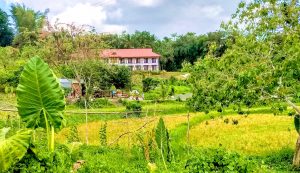
Hotel Complex, Damires Hills
That fact leads us inevitably, then, to another similarity: the landscape is easily habitable. In a certain sense, looking at the Cotswolds is like looking at somebody’s backyard. Every aspect of it is made comfortable for human habitation. Similarly at Damires Hills, a look at the grounds below the area where all the buildings are (the cafe, the banquet huts, etc.) reveals the same incorporation of the landscape into a planned and orderly functionality that makes humans comfortable because it sustains the lives they lead. Other words come to mind to include in that description: inviting, comforting, welcoming, accommodating. Perhaps the best word is: collaborative. This is, after all, a farm resort. Rice grows in the bottom of the little valley the resort buildings overlook. As you come back on the path from the Canopy Walk you pass a field of pineapples. It’s comfortable Nature that will feed you in addition to being pleasant to the eye and good for a stroll — just like the Cotswolds with its market gardens and fields of grain and pastures. It’s above all a place for walking, which one comes across so very seldom in the Philippines. No wonder I feel as though I’m in Gloucestershire.
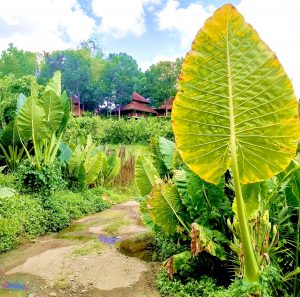
View Toward Cafe, Damires Hills
The feeling comes from past experience of mine, obviously, but it’s strong enough to hold even in the face of incontrovertible evidence that Gloucestershire is very far away. Take, for example, the taro plant, which has leaves taller than I am and far wider (which is saying something these days, trust me). Or take as another example something I came across while I crossed the hanging bridge on the Canopy Walk: a burst of yellow bloom in the top of one of the trees. From the flower form it’s clearly a species of Ipomoea, morning glory, but absolutely the last place I expected to see such an apparition was in the canopy of a tall tree. Obviously the vine had climbed the entire height of the tree and carried on its business quite happily at high elevation. That’s something you’d never see in the Cotswolds, of course. Morning glories there know their place and stick close to the ground, and in all likelihood are really in the Convolvulus branch of the family, which is decidedly poor relations, as anyone with an ounce of good breeding will tell you.
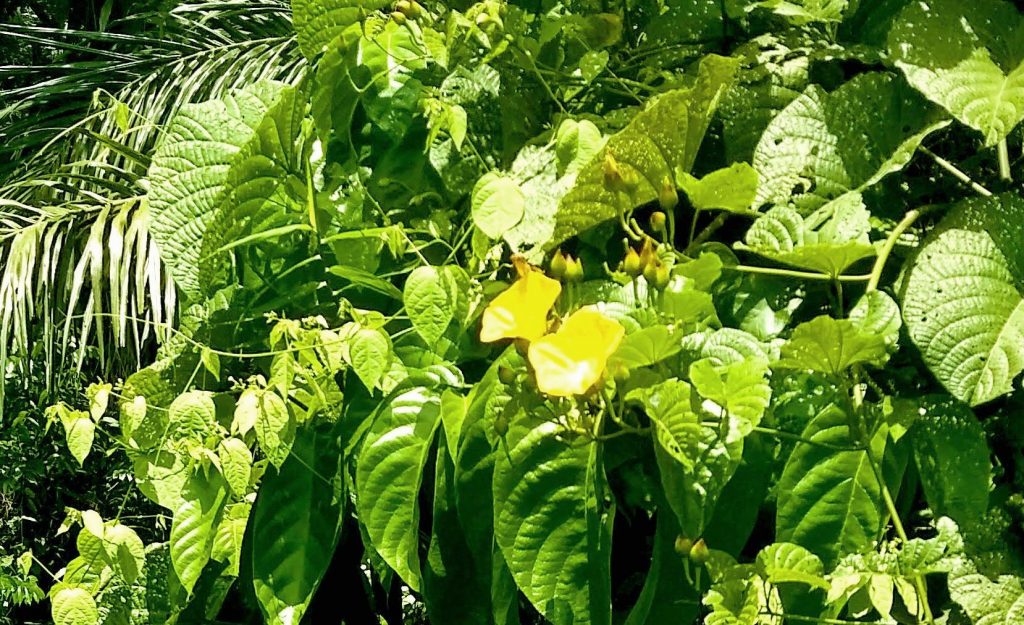
Ipomoea, Damires Hills
You might be astonished to know that my feeling of being in the Cotswolds holds firm even when I’m standing in front of a taro leaf bigger than I myself am or when I’m ogling yellow flowers blooming in the tops of trees. It’s not a willing suspension of disbelief, either, not at all. The eye sees what it sees, the body knows what it knows, and the association I carry comes from the physical level of my beingness, not the mental. The body knows from the evidence the eye presents that life can happen easily here. There is no danger. Room to move is ample and the processes of nature are not impeded, they are channelled into particular things humans, that odd lot, find useful. So it’s all good. We’re all going to heaven and Vandyck is of the company. As long as it’s not pissing down rain LOL.
As I walked in the forest up the hill toward the Canopy Walk, I became acutely aware of another important factor: the resort is one of the few places that affords easy access to a variety of natural environments. There are few places in the Philippines where such access is easily available. In the UK, on the other hand, a law was passed in 2000, the Countryside and Rights of Way Act, that provides for access by the general public to both public and private lands. Obviously, walking in England is a Big Deal, much more so than in the Philippines. Damires Hills is one of the few places that has a large enough acreage to afford a walk through different terrains — cropland, forest, cultivated fields and the grounds of the resort proper, which are beautifully landscaped with a wide variety of foliage and flowering plants. So there’s another chalk mark on the list of similarities with the Cotswolds, which is walking country par excellence.
I was the only person on the path as I went to the Canopy Walk and I met nobody on the way back to the cafe. That’s a good thing. It’s lovely to see people having a good time and Filipinos are expert in that department, especially the young ones. I find it charming to see the two swimming pools full of people, all Filipino on the days I have visited the resort, splashing about and squealing and having a grand old time. But the resort in my mind is completely dissociated from that sort of activity now. It’s a kind of nature reserve, a place I know I can visit when I want to spend the day looking at the forest, or feeling the soil under my feet as I walk on the path through the rice fields, or standing on the hill far away from the noise and bustle of the resort proper to look out over the lovely Panay countryside with the mountains of Antique rising in the distance. So pay no attention to the tourist brochure if those things are what you find your heart set on: you will find them there, just as I do. Good on you, Damires Hills.
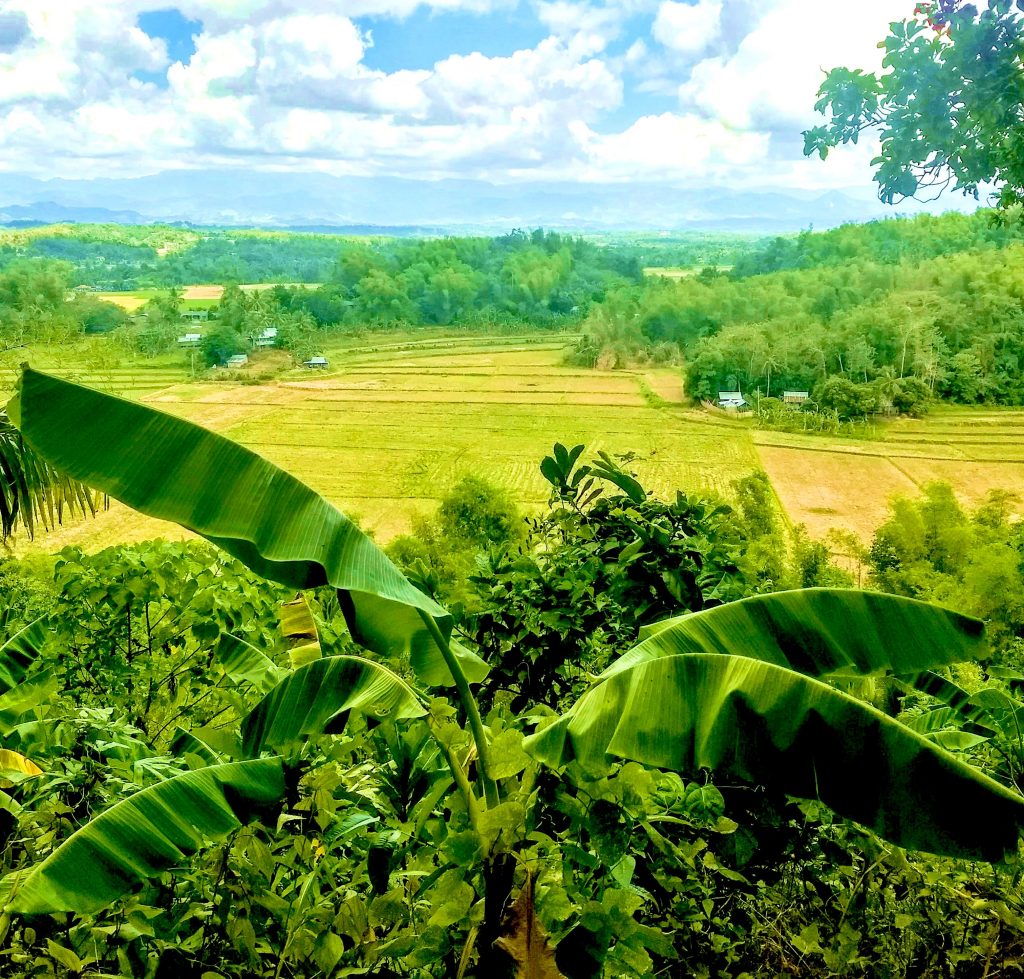
View near Canopy Walk, Damires Hills
